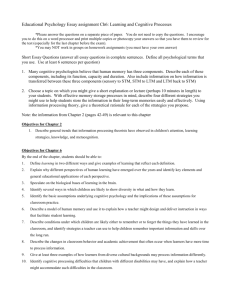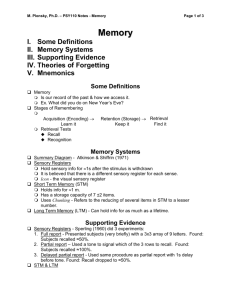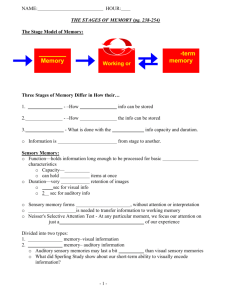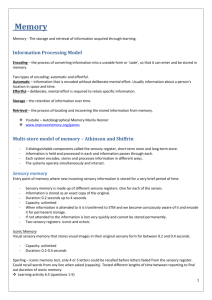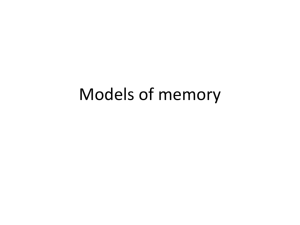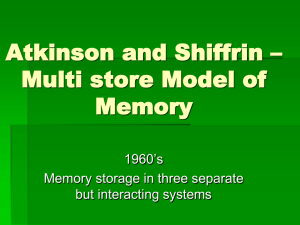Information Processing Theory: Memory & Learning
advertisement
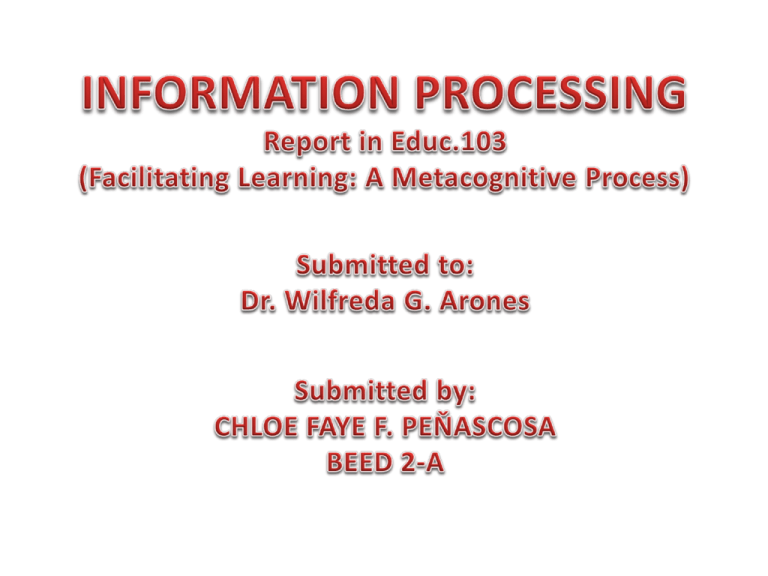
Information Processing Theory Types of Knowledge Stages General/Specific Encoding Declarative Storage Procedural Episodic Conditional Retrieval Executive Control Processes Information Processing Is a cognitive theoretical framework that focuses on how knowledge enters and is stored and retrieved from our memory. It focus on how people attend to environmental events, encode information to be learned and relate it to knowledge in memory, store new knowledge in memory and retrieved it as needed. Information Processing Theory This theory uses the computer metaphor with its inputs and outputs. Cognitive psychologists believe that cognitive processes influence the nature of what is learned. They consider learning as largely an internal process, not an external behavior change (as behaviorist theorists thought). They look into how we receive, perceive, store and retrieve information. They believe that how a person thinks about and interprets what s/he receives shapes what he/she will learn. All these notions comprise what is called the information processing theory. IPT describes how the learner receives information (stimuli) from the environment through the senses and what takes place in between determines whether the information will continue to pass through the sensory register, then the short term memory and the long term memory. Types of Knowledge General vs. Specific: This involves whether the knowledge is useful in many tasks, or only in one. Declarative: This refers to factual knowledge. They relate to the nature of how things are. They may be in the form of a word or an image. Procedural: This includes knowledge on how to do things. Episodic: this includes memories of life events, like your high school graduation. Conditional: This is about “knowing when and why” to apply declarative or procedural strategies. Stages in the Information Processing Theory The stages of IPT involve the functioning of the senses, sensory register, short term memory and the long term memory. Basically, IPT asserts three primary stages in the progression of external information becoming incorporated into the internal cognitive structure of choice (schema, concept, script, frame, mental model, etc. Three Primary Stages in IPT 1. Encoding information is sensed, perceived, and attended to. when information comes into our memory system (from a sensory input) it needs to be changed into a form that the system can cope with so that it can be stored. “Three Main Ways in which Information can be encoded” Visual (picture) Acoustic (sound) Semantic (meaning) 2. Storage The information is stored for either a brief or extended period of time, depending upon the processes following encoding. This concerns the nature of memory stores, i.e. where the information is stored, how long the memory lost for, how much can be stored at any time and what kind of information is held. 3. Retrieval The information is brought back at the appropriate time, and reactivated for use on a current task, the true measure of effective memory. Refers to getting information out storage Three Main Stages in the Memory Process 1. Sensory Register The main purpose of sensory register is to screen incoming stimuli and process only those stimuli that are most relevant at the present time. Capacity: Our mind receives a great amount of information but it is more than what our minds can hold or perceive. Duration: The sensory register only holds the information for an extremely brief – in the order of 1 to 3 seconds. There is a difference in duration based on modality: auditory memory is more persistent than visual. 2. Short Term Memory (STM or Working Memory) Capacity: The STM can only hold 5 to 9 “chunks” of information, sometimes described as 7 + /- 2. it is called working memory because it is where new information is temporarily placed while it is mentally processed. STM maintain information for a limited time, until the learner has adequate resources to process the information, or until the information is forgotten. Duration: Around 18 seconds or less. To reduce the loss of information in 18 seconds, you need to do maintenance rehearsal. It is using the repetition to keep the information active in STM, like when you repeat a phone number just given over and over. 3. Long Term Memory (LTM) The LTM is the final or permanent storing house for memory information. It holds the stored information until needed again. Capacity: LTM has unlimited capacity. Duration: Duration in the LTM is indefinite. Executive Control Processes Involve the executive processor or what is referred to as metacognitive skills. These processes guide the flow of information through the system, help the learner make informed decisions about how to categorize, organize, or interpret information. Forgetting Is the inability to retrieve or access information when needed. Why do we forget? There are 2 simple answer to this question. First, the memory has disappeared – it is no longer available. Second, the memory is still stored in the memory system but, for some reason it cannot be retrieved. Two Main Ways in which Forgetting Likely Occurs 1. Decay – Information is not attended to and eventually “fades” away. Very prevalent in Working Memory. 2. Interference – New or old information “blocks” access to the information in question. Proactive (pro-forward) occurs when you cannot learn a new tasks because of an old task that had been learn. Retroactive (retro-backward) occurs when you forget a previously learnt task due to the learning of a new task. Methods for Increasing Retrieval of Information Rehearsal – this is repeating information verbatim, either mentally or aloud. Meaningful Learning – this is making connections between new information and prior knowledge. Organization – it is making connections among various pieces of information. Elaboration – this is adding additional ideas to new information based on what one already knows. Visual Imagery – this means forming a ‘picture” of the information. Generation – things we “produce” are easier to remember than things we “’hear”. Context – remembering the situation helps recover information. Personalization – it is making the information relevant to the individual. Other Memory Methods Serial Position Effect (recency & primacy) – you will remember the beginning and end of “list” most readily. Part Learning – break up the “list” or “chunk” information to increase memorization. Distributed Practice – break up learning sessions, rather than cramming all the info in at once (Massed Practice) Mnemonic Aids – these are memory techniques that learners may employ to help them retain and retrieved information more effectively. Executive control Processes (including Metacognition) Maintenance Rehearsal Sensory memory Sense decay Perception Sensory memory Forgetting Rehearsal, Elaboration, Meaningful Learning, Organization, Visual Imagery, Generalization Sensory memory Retrieved Information processing model postulates a three component model of I.P. sensory and STM are limited with respect to capacity and duration, whereas LTM is more or less unlimited. Information is received through the senses and goes to the sensory memory for a very brief amount of time. If not found relevant, information may decay. It goes to the STM and if given attention and is perceived and found to be relevant, it is sent to the LTM. If not properly encoded, forgetting occurs. Different cognitive processes applied to the information will then determine if information can be retrieved when needed later. References: Lucas, Maria Rita D. and Brenda B. Corpuz.(2013). facilitating learning: a metacognitive process.(3rd Edition). Quezon City, Metro Manila: Lorimar Publishing, Inc. Matlin, Margeret W. (2005). Cognition. Crawfordsville: John Willey & Sons, Inc. Miller, G.A. (1956). The magical number seven, plus or minus two: Some Limits on our capacity for processing information. Psychological Review, 63 (2): 81-87.

